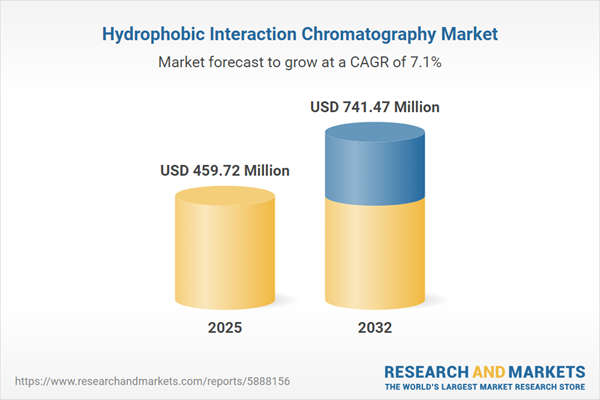Speak directly to the analyst to clarify any post sales queries you may have.
The hydrophobic interaction chromatography market is evolving rapidly due to ongoing changes in bioprocessing practices and regulatory requirements. Senior executives must actively engage with these developments to secure operational continuity and drive strategic advantage in a complex vendor landscape.
Market Snapshot: Hydrophobic Interaction Chromatography Market Insights
The hydrophobic interaction chromatography market is expanding, fueled by increased investment in bioprocessing across the biotechnology and pharmaceutical industries. The adoption of advanced purification technologies is improving both laboratory and large-scale manufacturing efficiency. Companies are enhancing quality management and ensuring process scalability to align with changing policy demands. Supplier relationships are being reshaped for resilience, with procurement strategies and supply security gaining greater importance. As workflow complexity increases, robust chromatographic methods are helping organizations maintain regulatory compliance and flexibility. Senior decision-makers must regularly review and update market-facing strategies to remain competitive in this changing environment.
Scope & Segmentation
This report provides senior leaders in procurement, technology selection, and supply chain management with actionable segmentation intelligence and transparent analysis of market structure. Key segmentation points include:
- Product: Chromatography columns, high-performance resins, and process consumables catering to applications from early research to full-scale manufacturing.
- Application: Utilization spans diagnostic assays, proteomics, metabolomics, and purification of biomolecules (such as vaccines, monoclonal antibodies, and recombinant proteins), offering solutions for varied throughput and regulatory needs.
- End Users: Academic institutions, biotechnology firms, contract research providers, and pharmaceutical manufacturers depend on these tools for both compliance and commercial purposes.
- Matrix Type: Agarose, methacrylate, polystyrene, and silica-based matrices are selected based on operational efficiency and regulatory requirements.
- Mode: Options include custom-built and prepacked column formats, ensuring fit for both routine and specialized workflow environments.
- Regions: North America, Latin America, Europe, Middle East, Africa, and Asia-Pacific each influence supply chain decisions through unique regulatory frameworks and technology adoption trends.
- Key Players: Danaher Corporation, Thermo Fisher Scientific Inc., Merck KGaA, Bio-Rad Laboratories, Agilent Technologies, Waters Corporation, Shimadzu Corporation, Tosoh Corporation, Sartorius AG, and JSR Life Sciences Corporation are shaping global innovation and setting industry standards.
Key Takeaways for Senior Decision-Makers
- Next-generation resins and column technologies are rapidly improving purification capabilities, supporting swift adaptation to research and production shifts.
- Advances in process automation and analytics allow procurement and supply chain teams to manage volatility and optimize resource allocation.
- Adoption of more sustainable practices, including efficient solvent management, supports compliance with evolving environmental regulations and sector expectations.
- Strengthened supplier engagement and regional network development provide organizations with greater procurement flexibility in addressing regulatory variability.
- Flexible solution selection across both R&D and commercial-scale requirements eases transition and supports continuity in diverse operating environments.
- Attention to regional complexities, particularly in Asia-Pacific and the Middle East, demands tailored approaches for compliant and timely market entry.
Tariff Impact on the Hydrophobic Interaction Chromatography Supply Chain
Recent changes to tariff policies on U.S. chromatography imports have heightened complexity for supply chain leaders. Organizations are prioritizing domestic production strategies, reinforcing national supplier relationships, and maintaining higher inventory reserves. These measures help manage risks from shifts in global trade dynamics, ensuring more secure access to essential inputs as regulatory conditions evolve.
Methodology & Data Sources
This report draws on insights from senior industry interviews, systematic review of published literature, and continuous monitoring of policy changes, giving decision-makers up-to-date, actionable intelligence on the hydrophobic interaction chromatography space.
Why This Report Matters
- Delivers actionable insights designed to enhance procurement processes, improve risk management, and strengthen compliance for chromatography market stakeholders.
- Clarifies emerging technological and supplier trends, empowering senior leaders to steer investments and operations with confidence amid sector change.
- Prepares organizations for new regulatory and sustainability demands, supporting long-term adaptive performance and operational resilience.
Conclusion
Achieving operational flexibility is vital as hydrophobic interaction chromatography continues to advance. Applying industry best practices from this analysis ensures organizations can respond effectively and sustain business performance during ongoing sector transformation.
Additional Product Information:
- Purchase of this report includes 1 year online access with quarterly updates.
- This report can be updated on request. Please contact our Customer Experience team using the Ask a Question widget on our website.
Table of Contents
3. Executive Summary
4. Market Overview
7. Cumulative Impact of Artificial Intelligence 2025
Companies Mentioned
The companies profiled in this Hydrophobic Interaction Chromatography market report include:- Danaher Corporation
- Thermo Fisher Scientific Inc.
- Merck KGaA
- Bio-Rad Laboratories, Inc.
- Agilent Technologies, Inc.
- Waters Corporation
- Shimadzu Corporation
- Tosoh Corporation
- Sartorius AG
- JSR Life Sciences Corporation
Table Information
| Report Attribute | Details |
|---|---|
| No. of Pages | 192 |
| Published | November 2025 |
| Forecast Period | 2025 - 2032 |
| Estimated Market Value ( USD | $ 459.72 Million |
| Forecasted Market Value ( USD | $ 741.47 Million |
| Compound Annual Growth Rate | 7.0% |
| Regions Covered | Global |
| No. of Companies Mentioned | 11 |









